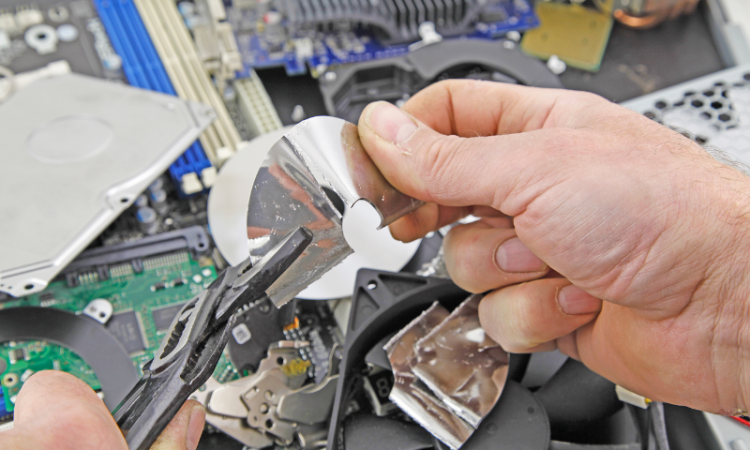
Data destruction is a critical aspect of modern information management. Ensuring sensitive data is irretrievably destroyed is paramount to avoiding data breaches and safeguarding privacy. As organisations rely more on data storage, knowing how to handle data destruction efficiently and securely is essential.
Learn the proper data destruction methods, including data centre decommissioning and IT asset disposition (ITAD), while ensuring compliance with regulations.
Understanding Data Destruction
Data destruction refers to eliminating data from electronic storage devices, making it irretrievable. Proper data destruction goes beyond deleting files or formatting hard drives, as these methods leave traces that can be recovered. Secure destruction ensures the complete erasure of data, protecting an organisation from unauthorised access.
Several methods can achieve secure data destruction, such as physical destruction, degaussing, and software-based erasure. Physical destruction, like shredding hard drives, is one of the most effective methods but prevents equipment reuse. Degaussing erases magnetic data by disrupting the magnetic fields on the device, making data inaccessible. Software-based erasure, meanwhile, uses specialised tools to overwrite data, allowing the hardware to remain functional for future use.
Organisations must select the right method based on the sensitivity of the data and the future use of the hardware. The balance between security and sustainability often leads many towards ITAD solutions, as they help recycle and repurpose assets after the secure removal of data.
The Role of Data Centre Decommissioning in Data Destruction
Data centre decommissioning is a large-scale process that involves shutting down data centre operations and securely removing all IT equipment. This process includes securely erasing data stored on servers, storage devices, and networking equipment before repurposing or recycling them.
Data centre decommissioning requires meticulous planning to ensure all critical systems are properly disconnected and data is securely erased. It goes beyond simply turning off equipment; it involves extracting, cataloguing, and securely wiping or destroying sensitive information to avoid data leaks.
Failure to follow proper decommissioning procedures could leave an organisation exposed to serious risks, such as accidental data breaches, fines for non-compliance with data privacy regulations, and loss of customer trust. Partnering with a reliable service provider that specialises in data centre decommissioning and ITAD ensures that sensitive data is handled securely and the organisation complies with regulations.
IT Asset Disposition (ITAD) as a Comprehensive Solution
ITAD refers to managing and disposing of old or outdated IT assets in an environmentally responsible and secure manner. A proper ITAD programme ensures data destruction and hardware disposal follows regulatory guidelines while contributing to sustainability.
ITAD includes secure data erasure, hardware recycling, and certification of destruction, providing organisations with peace of mind that their data has been securely handled. ITAD providers use software erasure tools and physical destruction techniques to ensure compliance with data protection regulations. Organisations can also receive a certificate of destruction, verifying that the data has been permanently erased.
ITAD also helps companies manage the recycling or resale of their old hardware, providing a cost-efficient solution while promoting environmental sustainability. With the increasing focus on corporate responsibility, adopting an ITAD approach that balances data security with eco-friendly practices is a sound business strategy.
Secure Data Destruction: Key Considerations
Organisations must prioritise secure data destruction to protect their sensitive information. Here are several key considerations for ensuring data destruction processes are handled safely and effectively:
Regulatory Compliance
Many industries have strict regulations regarding data privacy and destruction. Ensuring compliance with these regulations is critical to avoid fines or legal repercussions.
Method Selection
Choosing the right destruction method depends on the sensitivity of the data and the organisation’s future hardware needs. For high-risk data, physical destruction might be the best choice, while software-based erasure is suitable for less critical data and reusable equipment.
Partnering with Experts
Working with a specialised service provider experienced in ITAD and data centre decommissioning guarantees that data destruction is managed professionally and according to legal standards. These providers offer certified destruction services, giving organisations peace of mind that their data is securely handled.
Documentation and Verification
Certificates of destruction prove that data has been completely and securely erased. Ensuring proper documentation throughout the process can protect the organisation from liability in the event of future audits.
Protecting your organisation’s data requires secure and reliable methods of data destruction. Ensure peace of mind by choosing a trusted partner to handle your data centre decommissioning and ITAD needs. Visit Metalo International for professional data centre decommissioning and e-waste recycling services in Singapore.




